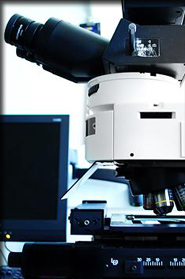Environmental and Occupational Health Sciences Institute
Toxicology Division
Carcinogenicity
- Progression of hormone-dependent mammary tumors in the ACI rat model is altered by exposure to environmental factors that influence the expression of key antioxidant enzymes.
- Transgenic mouse model system to study melanoma development.
- Aberrant expression of a G-protein-coupled-seven-transmembrane-domain protein, metabotropic glutamate receptor (Grm1) in melanocytes is sufficient to induce melanocytic neoplasia in vivo.
- Assessment of the mechanism by which up-regulation of the transmembranous extracellular matrix molecules EMMPRIN and collagen XXIII increase metastatic potential and evaluation of the use of these molecules in assessing the carcinogenic potential of environmental agents.
- Defining the carcinogenic constituents of tobacco smoke and elucidating the mechanisms of their carcinogenicity.
- Mechanisms of free radical-induced signal transduction in ultraviolet light carcinogenesis.
- Mechanism of action of dietary nutrients that are inhibitors of the carcinogenic process.
- Characterization of the mechanism of action of photosensitizers using keratinocytes and melanocytes in culture.
- Spermine increases the binding of the activating transcription factor ATF-2 known to be involved in the transcription of cell cycle regulatory genes and in the proliferation of breast cancer cells, to DNA and enhanced the transcriptional activation of cyclin D1, a critical cell cycle regulatory protein.
- Use of microarray techniques to examine the effects of a polyamine biosynthetic inhibitor (difluoromethylornithine, DFMO) on estradiol-induced expression of genes in MCF-7 cells.
- Evaluation of the effects of estradiol and the estrogen response element (ERE) on the CD spectral characteristics and unfolding of ERbeta to gain information about ligand and ERE-induced changes in the conformation and stability of the protein.


